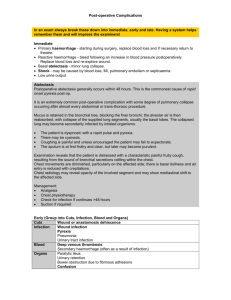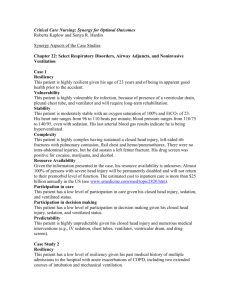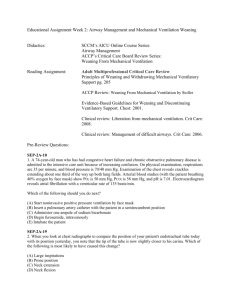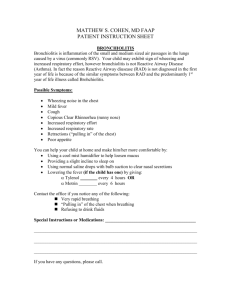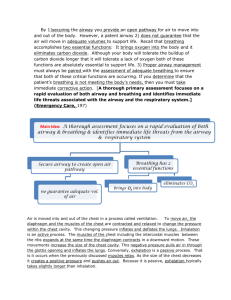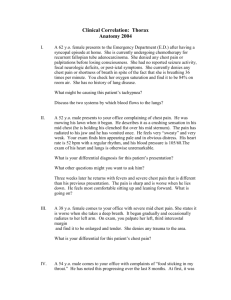Acute Lobar Atelectasis During Mechanical Ventilation: To Beat
advertisement
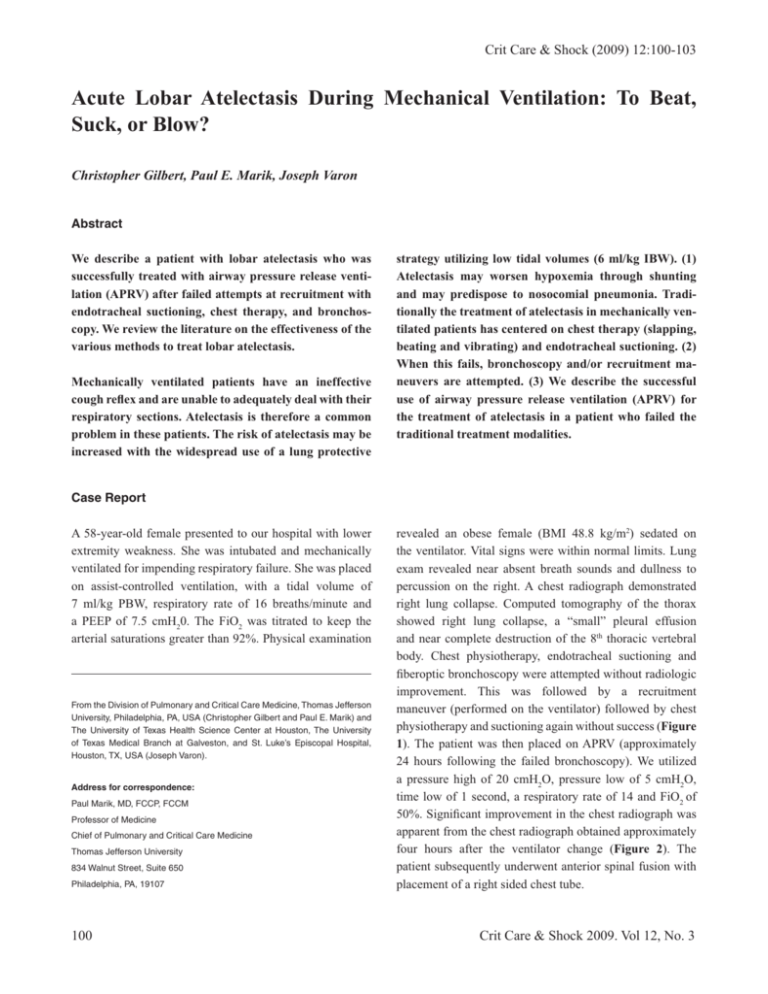
Crit Care & Shock (2009) 12:100-103 Acute Lobar Atelectasis During Mechanical Ventilation: To Beat, Suck, or Blow? Christopher Gilbert, Paul E. Marik, Joseph Varon Abstract We describe a patient with lobar atelectasis who was successfully treated with airway pressure release ventilation (APRV) after failed attempts at recruitment with endotracheal suctioning, chest therapy, and bronchoscopy. We review the literature on the effectiveness of the various methods to treat lobar atelectasis. Mechanically ventilated patients have an ineffective cough reflex and are unable to adequately deal with their respiratory sections. Atelectasis is therefore a common problem in these patients. The risk of atelectasis may be increased with the widespread use of a lung protective strategy utilizing low tidal volumes (6 ml/kg IBW). (1) Atelectasis may worsen hypoxemia through shunting and may predispose to nosocomial pneumonia. Traditionally the treatment of atelectasis in mechanically ventilated patients has centered on chest therapy (slapping, beating and vibrating) and endotracheal suctioning. (2) When this fails, bronchoscopy and/or recruitment maneuvers are attempted. (3) We describe the successful use of airway pressure release ventilation (APRV) for the treatment of atelectasis in a patient who failed the traditional treatment modalities. Case Report A 58-year-old female presented to our hospital with lower extremity weakness. She was intubated and mechanically ventilated for impending respiratory failure. She was placed on assist-controlled ventilation, with a tidal volume of 7 ml/kg PBW, respiratory rate of 16 breaths/minute and a PEEP of 7.5 cmH20. The FiO2 was titrated to keep the arterial saturations greater than 92%. Physical examination From the Division of Pulmonary and Critical Care Medicine, Thomas Jefferson University, Philadelphia, PA, USA (Christopher Gilbert and Paul E. Marik) and The University of Texas Health Science Center at Houston, The University of Texas Medical Branch at Galveston, and St. Luke’s Episcopal Hospital, Houston, TX, USA (Joseph Varon). Address for correspondence: Paul Marik, MD, FCCP, FCCM Professor of Medicine Chief of Pulmonary and Critical Care Medicine Thomas Jefferson University 834 Walnut Street, Suite 650 Philadelphia, PA, 19107 100 revealed an obese female (BMI 48.8 kg/m2) sedated on the ventilator. Vital signs were within normal limits. Lung exam revealed near absent breath sounds and dullness to percussion on the right. A chest radiograph demonstrated right lung collapse. Computed tomography of the thorax showed right lung collapse, a “small” pleural effusion and near complete destruction of the 8th thoracic vertebral body. Chest physiotherapy, endotracheal suctioning and fiberoptic bronchoscopy were attempted without radiologic improvement. This was followed by a recruitment maneuver (performed on the ventilator) followed by chest physiotherapy and suctioning again without success (Figure 1). The patient was then placed on APRV (approximately 24 hours following the failed bronchoscopy). We utilized a pressure high of 20 cmH2O, pressure low of 5 cmH2O, time low of 1 second, a respiratory rate of 14 and FiO2 of 50%. Significant improvement in the chest radiograph was apparent from the chest radiograph obtained approximately four hours after the ventilator change (Figure 2). The patient subsequently underwent anterior spinal fusion with placement of a right sided chest tube. Crit Care & Shock 2009. Vol 12, No. 3 Discussion Bronchoscopy is a commonly performed treatment of atelectasis, with reports indicating that more than 50% of bronchoscopies performed in the ICU are for retained secretions and/or atelectasis. (4,5) However, the utility of fiberoptic bronchoscopy (FOB) for the treatment of atelectasis is unclear. Olopade and Prakesh reviewed the experience at the Mayo Clinic over a 4 year period from 1985 to 1988. (5) During this period 90 fiberoptic bronchoscopies were performed for atelectasis and retained secretions, with only 17 (19%) of patients demonstrating an improvement in oxygenation or radiographic changes following the procedure. Stevens and colleagues reported their experience with 297 fiberoptic bronchoscopies in 223 ICU patients. (6) Of the 118 patients in whom FOB was performed for atelectasis 93 (79%) showed an improvement in aeration on examination, oxygenation, or chest radiographic appearance. However, of the 70 patients in whom bronchoscopy was performed for retained secretions, only 31 (44%) improved following the procedure. Marini and colleagues, in the only randomized controlled study reported to date, compared an aggressive chest therapy regimen with that of FOB in 31 patients with acute lobar atelectasis. (3) Forty-three percent of the patients in this study were intubated at the time of treatment. Chest therapy was performed 4 hourly in both groups and included deep breathing (non-intubated patients) or manual inflations and endotracheal suctioning, as well as nebulization and chest percussion. In this study, approximately 65% of the volume loss on the chest radiograph was restored by 24 hours (and 80% at 48 hours) with no difference between groups (ventilated bronchoscopy vs. chest therapy and nonventilated bronchoscopy vs. chest therapy). Respiratory therapy refers to “treatments” provided by the respiratory therapist to aid in lung expansion and mobilize retained secretions. This includes techniques to loosen and mobilize secretions including saline instillation, endotracheal suctioning and chest clapping/vibration and recruitment (hyperinflation) maneuvers. Manual hyperinflation delivers a large tidal volume breath over a prolonged inspiratory time, followed by an inspiratory hold and a rapid release of pressure. (2) The goal is to stimulate cough and propel mucous cephalad. There is limited data with respect to the efficacy of manual hyperinflation, however, high airway Crit Care & Shock 2009. Vol 12, No. 3 pressure and large lung volumes may produce adverse homodynamic effects and injure the lung via barotrauma and/or volutrauma. Maa and colleagues performed a randomized controlled trial in which ventilated patients with atelectasis were randomized to manual hyperinflations (lasting 20 minutes) three times a day or to “standard” care. (2) In this study, manual hyperinflations were performed by a single investigator using a predefined protocol which limited peak airway pressure to 20 cmH2O. Spontaneous tidal volumes, oxygenation, sputum volume and the chest radiographic score increased in the treatment group whereas these indices remained largely unchanged in the standard care group. The mechanical ventilator can be used to achieve hyperinflation with similar results. (7,8) This approach may be safer as the inflation volumes and pressures can be preset. High frequency chest wall vibration/compression/ ossicilation, rib cage compression (or squeezing) and chest wall “clapping/slapping” have been used to loosen and mobilize secretions. There is however no evidence that any of these interventions have any beneficial effects and they are currently not recommended in mechanically ventilated patients. (9,10) Non-invasive modes of ventilation which provide positive pressure, including continuous positive airway pressure (CPAP), bilevel positive airway pressure and pressure support ventilation have been used successfully in surgical patients to both prevent (10-12) and treat (13) post-operative atelectasis. The use of sustained increased airway pressures using, bilevel or APRV to treat atelectasis in adult patients undergoing mechanical ventilation has not been previously reported. Although recruitment maneuvers may be effective in improving gas exchange and compliance, these effects are not sustained; APRV may be viewed as a nearly continuous recruitment maneuver. (14) The ventilator maintains a high-pressure setting for the bulk of the respiratory cycle (PHigh), which is followed by a periodic release to a low pressure (PLow). (15) The periodic releases aid in carbon dioxide elimination (CO2). The release periods (TLow) are kept short (0.7-1 s); this prevents derecruitment and enhances spontaneous breathing during THigh. (16-17) The advantages of APRV over volume controlled ventilation include an increase in mean alveolar pressure with alveolar recruitment, the hemodynamic and ventilatory benefits associated with spontaneous breathing and the reduced 101 requirement for sedation. Ventilation modes such as APRV are likely to be more successful than conventional recruitment maneuvers as they provide a more gradual and prolonged recruitment of alveoli. We present a case in which APRV was successful in recruiting collapsed lung after aggressive chest physiotherapy, recruitment maneuvers and bronchoscopy had failed. We have subsequently used this technique successfully in a number of additional patients. We believe that endotracheal suctioning and APRV may be the preferred approach to the recruitment of collapsed lung in intubated patients. Figure 1. Initial Chest Radiograph Demonstrating Right Lobar Collapse. Figure 2. Chest Radiograph Following 4 Hours of APRV. 102 Crit Care & Shock 2009. Vol 12, No. 3 References 1. Kallet RH, Siobal MS, Alonso JA, Warnecke EL, Katz JA, Marks JD. Lung collapse during low tidal volume ventilation in acute respiratory distress syndrome. Respir Care 2001;46:49-52. 2. Maa SH, Hung TJ, Hsu KH, Hsieh YI, Wang KY, Wang CH, et al. Manual hyperinflation improves alveolar recruitment in difficult-towean patients. Chest 2005;128:2714-21. 3. Marini JJ, Pierson DJ, Hudson LD. Acute lobar atelectasis: a prospective comparison of fiberoptic bronchoscopy and respiratory therapy. Am Rev Respir Dis 1979;119:971-8. 4. Jolliet P, Chevrolet JC. Bronchoscopy in the intensive care unit. Intensive Care Med 1992;18:160-9. 5. Olopade CO, Prakash UB. Bronchoscopy in the critical-care unit. Mayo Clinic Proceedings 1989;64:1255-63. 6. Stevens RP, Lillington GA, Parsons GH. Fiberoptic bronchoscopy in the intensive care unit. Heart Lung 1981;10:1037-45. 7. Savian C, Paratz J, Davies A. Comparison of the effectiveness of manual and ventilator hyperinflation at different levels of positive end-expiratory pressure in artificially Crit Care & Shock 2009. Vol 12, No. 3 ventilated and intubated intensive care patients. Heart Lung 2006;35:334-41. 8. Berney S, Denehy L. A comparison of the effects of manual and ventilator hyperinflation on static lung compliance and sputum production in intubated and ventilated intensive care patients. Physiother Res Int 2002;7:100-8. 9. Branson RD. Secretion management in the mechanically ventilated patient. Respir Care 2007;52:1328-42. 10.Chatburn RL. High-frequency assisted airway clearance. Respir Care 2007;52:122435. 11. Ferreyra GP, Baussano I, Squadrone V, Richiardi L, Marchiaro G, Del Sorbo L, et al. Continuous positive airway pressure for treatment of respiratory complications after abdominal surgery: a systematic review and meta-analysis. Ann Surg 2008;247:617-26. 12.Matte P, Jacquet L, Van Dyck M, Goenen M. Effects of conventional physiotherapy, continuous positive airway pressure and non-invasive ventilatory support with bilevel positive airway pressure after coronary artery bypass grafting. Acta Anaesthesiol Scand 2000;44:75-81. 13.Pasquina P, Tramèr MR, Granier JM, Walder B. Respiratory physiotherapy to prevent pulmonary complications after abdominal surgery: a systematic review. Chest 2006;130:1887-99. 14.Hemmila MR, Napolitano LM. Severe respiratory failure: advanced treatment options. Crit Care Med 2006;34:S278-90. 15.Rose L, Hawkins M. Airway pressure release ventilation and biphasic positive airway pressure: a systematic review of definitional criteria. Intensive Care Med 2008;34:176673. 16.Neumann P, Golisch W, Strohmeyer A, Buscher H, Burchardi H, Sydow M. Influence of different release times on spontaneous breathing pattern during airway pressure release ventilation. Intensive Care Med 2002;28:1742-9. 17.Myers TR, MacIntyre NR. Respiratory controversies in the critical care setting. Does airway pressure release ventilation offer important new advantages in mechanical ventilator support? Respir Care 2007;52:452-8. 103

